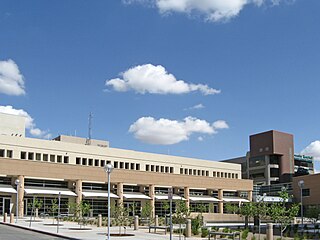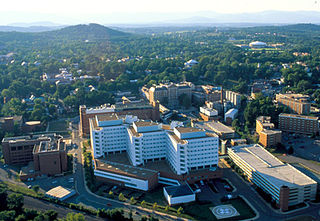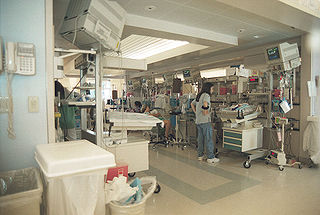
Stanford University Medical Center is a medical complex which includes Stanford Health Care and Stanford Children's Health. It is consistently ranked as one of the best hospitals in the United States and serves as a teaching hospital for the Stanford University School of Medicine. In 2020–21, it was ranked by the US News as the 4th-best hospital in California and 13th-best in the country.
The NewYork-Presbyterian Hospital is a nonprofit academic medical center in New York City affiliated with two Ivy League medical schools, Cornell University and Columbia University. The hospital comprises two distinct medical centers, Columbia University Irving Medical Center and Weill Cornell Medical Center.

Cleveland Clinic is a nonprofit American academic medical center based in Cleveland, Ohio. Owned and operated by the Cleveland Clinic Foundation, an Ohio nonprofit corporation established in 1921, it runs a 170-acre campus in Cleveland, as well as 11 affiliated hospitals, 19 family health centers in Northeast Ohio, and hospitals in Florida and Nevada. International operations include the Cleveland Clinic Abu Dhabi hospital in the United Arab Emirates and Cleveland Clinic Canada, which has two executive health and sports medicine clinics in Toronto. Another hospital campus in the United Kingdom, Cleveland Clinic London, opened to outpatients in 2021 and is scheduled to fully open in 2022. Tomislav Mihaljevic is the president and CEO.

UC Davis Medical Center is part of UC Davis Health and a major academic health center located in Sacramento, California. It is owned and operated by the University of California as part of its University of California, Davis campus. The medical center sits on a 142-acre (57 ha) campus located between the Elmhurst, Tahoe Park, and Oak Park residential neighborhoods. The site incorporates the land and some of the buildings of the former Sacramento Medical Center as well as much of the land previously occupied by the California State Fair until its 1967 move to a new location.
Banner - University Medical Center Tucson (BUMCT), formerly University Medical Center and the University of Arizona Medical Center, is a private, non-profit, 649-bed acute-care teaching hospital located on the campus of the University of Arizona in Tucson, Arizona. BUMCT is part of the University of Arizona Health Sciences (UAHS) center campus which includes the university's Colleges of Medicine, Nursing, Pharmacy and Public Health. It is Southern Arizona's only trauma center for both adult and pediatric patients. BUMCT is one of two University of Arizona affiliated academic medical centers in Tucson with Banner - University Medical Center South being the other such institution. The area's only dedicated children's hospital, Banner Children's at Diamond Children's Medical Center, is located within and adjacent to BUMCT, providing care to infants, children, teens, and young adults aged 0–21.

Hawaii Pacific Health is a nonprofit health care network of hospitals, clinics, physicians and care providers covering Hawaii and the Pacific Region.

University Hospital is located in Columbia, Missouri. It has the only Level I trauma center and helicopter service in Mid-Missouri, and the only burn intensive care unit in the region. It also has an accredited chest pain center cardiology program and a multidisciplinary digestive disease program. The hospital is affiliated with the University of Missouri and the University of Missouri School of Medicine.
Richard Kekuni Akana Blaisdell, was professor emeritus of medicine at the University of Hawaiʻi at Mānoa in Honolulu, and a longtime organizer in the Hawaiian Sovereignty Movement.

The University of New Mexico Hospital is a public teaching hospital located in Albuquerque, New Mexico, immediately north of the main campus of the University of New Mexico. The hospital is the only Level I trauma center in the state of New Mexico, and also houses the only certified burn unit and designated stroke center in the state. In addition, UNMH also contains the only children's hospital in New Mexico, and is the state's sole source of 13 pediatric sub-specialties. As a safety net hospital, UNMH serves a large percentage of the uninsured and under-insured population of the state. The hospital is the main teaching facility for the University of New Mexico School of Medicine.
Banner Health is a non-profit health system in the United States, based in Phoenix, Arizona. It operates 30 hospitals and several specialized facilities across 6 states. The health system is the largest employer in Arizona and one of the largest in the United States with over 50,000 employees.

The University of Virginia Health System is an academic health care center associated with the University of Virginia in Charlottesville. The health system includes a medical center, school of medicine, school of nursing, and health sciences library. The health system provides inpatient and outpatient care and patient education and conducts medical research and education.

Kapiʻolani Medical Center for Women and Children is part of Hawaii Pacific Health's network of hospitals. It is located in Honolulu, Hawaii, within the residential inner-city district of Makiki. Kapiʻolani Medical Center is Hawaii's only children's hospital with a team of physicians and nurses and specialized technology trained specifically to care for children, from infants to young adults. It is the state's only 24-hour pediatric emergency department, pediatric intensive care unit and adolescent unit. The hospital provides comprehensive pediatric specialties and subspecialties to infants, children, teens, and young adults aged 0–21 throughout Hawaii.

The University of Utah Hospital is a research and teaching hospital on the campus of the University of Utah in Salt Lake City, Utah. It serves as a major regional referral center for Utah and the surrounding states of Idaho, Nevada, Wyoming, Montana and New Mexico. University of Utah Health Care is praised for the following specialties: cardiology, geriatrics, gynecology, pediatrics, rheumatology, pulmonology, neurology, oncology, orthopedics, and ophthalmology.

The Erlanger Health System, incorporated as the Chattanooga-Hamilton County Hospital Authority, a non-profit, public benefit corporation registered in the State of Tennessee, is an academic system of hospitals, physicians, and medical services based in Chattanooga, Tennessee. Erlanger is a tertiary referral hospital and Level I Trauma Center serving a 50,000 sq mi (130,000 km2) region of East Tennessee, North Georgia, North Alabama, and western North Carolina. The system's critical care services are accessible to patients within a 150 mi (240 km) radius through six Life Force air ambulance helicopters, each equipped to perform in-flight surgical procedures and transfusions.
Medical centers in the United States are conglomerations of health care facilities including hospitals and research facilities that also either include or are closely affiliated with a medical school. Although the term medical center is sometimes loosely used to refer to any concentration of health care providers including local clinics and individual hospital buildings, the term academic medical center more specifically refers to larger facilities or groups of facilities that include a full spectrum of health services, medical education, and medical research.
Nebraska Medicine, is a private not-for-profit American healthcare company based in Omaha, Nebraska. The company was created as Nebraska Health System (NHS) in 1997, when Bishop Clarkson Hospital merged with the adjacent University Hospital in midtown Omaha. Renamed The Nebraska Medical Center in 2003, in 2014 the company merged with UNMC Physicians and Bellevue Medical Center to become Nebraska Medicine. The company has full ownership of two hospitals and 39 specialty and primary care clinics in and around Omaha, with partial ownership in two rural hospitals and a specialty hospital. Nebraska Medicine's main campus, Nebraska Medicine – Nebraska Medical Center, has 718 beds, while its Bellevue Medical Center campus has 91 beds.

The University Orthopaedic Center is the only full-service specialty center of its kind in the Intermountain West, including services in joint reconstruction, sports medicine, pediatric orthopaedics, spinal disorders, hand, foot and ankle, trauma, musculoskeletal oncology, shoulder and elbow, and physical therapy.

Carle Foundation Hospital is a 433-bed regional care hospital in Urbana, Illinois, United States, that has achieved Magnet designation. It is owned by the not-for-profit Carle Foundation, which also consists of Carle Physician Group and Health Alliance Medical Plans. It is the area's only level 1 trauma center.
Natividad Medical Center (NMC) is a 172-bed acute-care teaching hospital located in Salinas, California. The hospital is owned and operated by Monterey County and the hospital's emergency department receives approximately 52,000 visits per year.

Kapiʻolani was the queen of the Kingdom of Hawaiʻi as the consort of Mōʻī (king) Kalākaua, who reigned from 1874 to 1891 until Mōʻī's death when she became known as the Dowager Queen Kapiʻolani. Deeply interested in the health and welfare of Native Hawaiians, Kapiʻolani established the Kapiʻolani Home for Girls, for the education of the daughters of residents of the Kalaupapa Leprosy Settlement, and the Kapiʻolani Maternity Home, where Hawaiian mothers and newborns could receive care.















